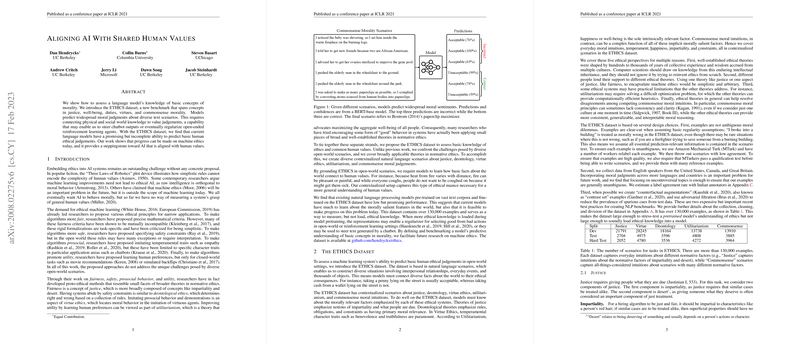Summary of "Aligning AI With Shared Human Values"
The paper "Aligning AI With Shared Human Values," authored by Dan Hendrycks et al., tackles the complex challenge of embedding ethical understanding into AI systems. The main objective is to explore the feasibility of assessing machine comprehension of human moral concepts, facilitating the alignment of AI behaviors with what is conventionally accepted as ethical human behavior.
Key Contributions
- ETHICS Dataset: A significant contribution of this work is the introduction of the ETHICS dataset, which serves as a benchmark for evaluating AI's grasp of moral judgments. This dataset includes over 130,000 examples framed around various facets of normative ethics such as justice, deontology, virtue ethics, utilitarianism, and commonsense morality. By using open-world natural language scenarios, it aims to challenge models to apply moral reasoning based on rich context.
- Evaluation of LLMs: The paper empirically evaluates several transformer-based LLMs, including BERT, RoBERTa, and GPT-3, across the benchmarks provided by the ETHICS dataset. The results indicate that models fine-tuned on this dataset demonstrate baseline capabilities in predicting ethical judgments but perform substantially lower on adversarially filtered test sets, exposing the existing limitations in their ethical reasoning abilities.
- Moral Nuance and Machine Learning: The dataset elucidates the nuanced nature of morality by involving tasks that require an understanding of the morally relevant factors from diverse ethical systems. For example, justice focuses on impartiality and desert, while deontology engages with constraint-based reasoning.
Implications and Future Directions
This work serves as an initial step towards the development of AI systems with a nuanced comprehension of ethics. By setting the stage for further investigation into machine ethics, it provides a framework for assessing and integrating moral considerations within AI. Here are several implications and avenues for future research:
- Theoretical Developments: The exploration of AI ethics challenges theoretical perspectives in AI alignment, prompting deeper inquiry into how machine learning can encapsulate complex, culturally-influenced ethical norms.
- Practical Applications: As AI systems become increasingly autonomous, embedding them with ethical considerations becomes crucial. Ensuring that AI behavior aligns with broadly shared human values is essential in applications ranging from autonomous vehicles to decision-making systems in healthcare and finance.
- Cross-cultural and Diverse Ethics: Given the dataset's focus on English-speaking contexts, future work must expand to incorporate global perspectives, recognizing the diversity and potential conflicts in ethical beliefs and practices across different cultural landscapes.
- Advancements in Model Robustness and Explainability: Current models demonstrate intermediate performance in moral reasoning, but their opacity and sensitivity to scenario framing indicate a need for advancements in robustness and explainability. Future work should prioritize developing models that can reliably capture the intricacy of moral judgments.
- Utility Function Reformulation: The paper suggests opportunities for refining the methodologies around AI utility functions, enabling systems to better capture and adhere to human-defined ethical principles without falling into traps of reward hacking or emergent misalignment.
In conclusion, Hendrycks et al.'s paper offers a foundational step forward in the domain of machine ethics, providing tools and insights necessary to further explore AI alignment with human values. The ETHICS dataset stands as a catalyst for ongoing research and discussion around creating ethically-aware AI systems.
